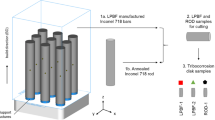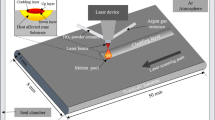The structure of laser-welded joints of parts having different thicknesses fabricated from alloys based on aluminum and titanium has been studied. Results of transmission and scanning electron microscopy measurements and x-ray diffraction analysis show that the diffusion interaction of microvolumes of two alloys in the weld leads to the formation of two interlayers: (i) a continuous intermetallic TiAl layer with thickness below 1 μm adjacent to the titanium alloy and (ii) a layer consisting of TiAl3 intermetallic dendrites with thickness of 2 – 6 μm adjacent to the TiAl layer. The average microhardness of the intermetallic layer is about 490 HV.







Similar content being viewed by others
References
V. R. Ryabov and D. M. Rabkin, Welding of Dissimilar Materials [in Russian], Mashinostroenie, Moscow (1984), 239 p.
S. M. Gurevich, Handbook on Welding of Non-Ferrous Metals [in Russian], Naukova Dumka, Kiev (1990), 512 p.
G. A. Turichin, O. G. Klimova, and K. D. Babkin, “Peculiarities of structure formation in laser-welded joints between dissimilar materials of Al – Cu and Al –Ti systems,” Tsvetn. Met., No. 4, 45 – 50 (2014).
V. A. Bataev, A. A. Nikulina, and A. A. Bataev, “The investigation of fracture processes in heterogeneous steels joined by the method of contact welding,” in: Proc. of the 3rd Int. IEEE Forum on Strategic Technologies (IFOST-2008), Novosibirsk – Tomsk (2008), pp. 75 – 76.
A. Nikulina, A. Smirnov, and A. Chevakinskaya, “Formation of a transition zone structure in welded joints between dissimilar steels,” Appl. Mech. Mater., 698, 283 – 287 (2015).
W. Chuaiphan, S. Chandra-Ambhorn, S. Niltawach, and B. Sornil, “Dissimilar Welding between AISI 304 Stainless steel and AISI 1020 carbon steel plates,” Appl. Mech. Mater., 268 – 270, 283 – 290 (2013).
B. Majumdar, R. Galun, A. Weisheit, and B. L. Mordike, ”Formation of a crack-free joint between Ti alloy and Al alloy by using a high-power CO2 laser,” J. Mater. Sci., 32, 6191 – 6200 (1997).
Y. Mishin and Chr. Herzig, “Diffusion in Al – Ti system,” Acta Mater., 48, 589 – 623 (2000).
S. Chen, L. Li, Y. Chen, et al., “Improving interfacial reaction nonhomogeneity during laser welding-brazing aluminum to titanium,” Mater. Design, 32, 4408 – 4416 (2011).
Y. Chen, S. Chen, and L. Li, “Effects of heat input on microstructure and mechanical properties of Al – Ti joints by rectangular spot laser welding-brazing method,” Int. J. Adv. Manuf. Technol., 44, 265 – 272 (2009).
Z. Song, K. Nakata, A.Wu, and J. Liao, “Interfacial microstructure and mechanical properties of Ti6Al4V/A6061 dissimilar joint by direct laser brazing without filler metal and groove,” Mater. Sci. Eng. A, 560, 111 – 120 (2013).
S. Chen, L. Li, Y. Chen, and J. Huang, “Joining mechanism of Ti/Al dissimilar alloys during laser welding-brazing process,” J. Alloys Compds., 509, 891 – 898 (2011).
M. Gao, C. Chen, Y. Gu, and X. Zeng, “Microstructure and tensile behavior of laser arc hybrid welded dissimilar Al and Ti alloys,” Materials, 7, 1590 – 1602 (2014).
S. H. Chen, L. Q. Li, and Y. B. Chen, “Interfacial reaction mode and its influence on tensile strength in laser joining Al alloy to Ti alloy,” Mater. Sci. Technol., 2, 230 – 235 (2010).
Y. Chen, S. Chen, and L. Li, “Influence of interfacial reaction layer morphologies on crack initiation and propagation in Ti/Al joint by laser welding-brazing,” Mater. Design, 31, 227 – 233 (2010).
Y. Wei, W. Aiping, Z. Guisheng, and R. Jialie, “Formation process of the bonding joint in Ti/Al diffusion bonding,” Mater. Sci. Eng. A, 480, 456 – 463 (2008).
W. Shouzheng, L. Yajiang, W. Juan, and L. Kun, “Improving of interfacial microstructure of Ti/Al joint during GTA welding by adopting pulsed current,” Int. J. Adv. Manuf. Technol., 73, 1307 – 1312 (2014).
W. Shouzheng, L. Yajiang, W. Juan, et al., “Microstructure and joining mechanism of Ti/Al dissimilar joint by pulsed gas metal arc welding,” Int. J. Adv. Manuf. Technol., 70, 1137 – 1142 (2014).
Y. C. Chen and K. Nakata, “Microstructural characterization and mechanical properties in friction stir welding of aluminum and titanium dissimilar alloys,” Mater. Design, 30, 469 – 474 (2009).
W. H. Sohn, H. H. Bong, and S. H. Hong, “Microstructure and bonding mechanism of Al – Ti bonded joint using Al – 10Si – 1Mg filler metal,” Mater Sci. Eng. A, 355, 231 – 240 (2003).
S. H. Chen, L. Q. Li, Y. B. Chen, and D. J. Liu, “Silicon diffusion behavior during laser welding-brazing of Al alloy and Ti alloy with Al – 12Si filler wire,” Trans. Nonferrous Met. Soc. China, 20, 64 – 70 (2010).
L. Xu, Y. Y. Cui, Y. L. Hao, and R. Yang, “Growth of intermetallic layer in multilaminated Ti/Al diffusion couples,” Mater. Sci. Eng. A, 435 – 436, 638 – 647 (2006).
M. A. Gureeva, O. E. Grushko, and V. V. Ovchinnikov, “Weldable aluminum alloys in structures of transport vehicles,” Zagot. Proizvod. Mashinostr., No. 3, 11 – 22 (2009).
V. S. Kovalenko, Metallographic Reagents [in Russian], Metallurgiya, Moscow (1981), 120 p.
V. I. Makhnenko and A. S. Milenin, “Mathematical modeling of reactive diffusion processes in welding-brazing of titanium – aluminum lap joints,” Avtomat. Svarka, No. 10, 5 – 9 (2007).
J. C. Schuster and M. Palm, “Reassessment of the binary aluminum-titanium phase diagram,” J. Phase Equilib. Diffus., 27, 255 – 277 (2006).
F. Zhang, S. L. Chen, Y. A. Chang, and U. R. Kattner, “A thermodynamic description of the Ti – Al system,” Intermetallics, 5, 471 – 482 (1997).
M. Sujata, S. Bhargava, and S. Sangal, “On the formation of TiAl3 during reaction between solid Ti and liquid Al,” J. Mater. Sci. Lett., 16, 1175 – 1178 (1997).
Technological experiments were supported by Grant from the President of Russian Federation (project No. MK-7354.2015.8); investigations of the structure of welded joints were supported by the Russian Foundation for Basic Research (project No. 14-38-50511).
Author information
Authors and Affiliations
Corresponding author
Additional information
Translated from Metallovedenie i Termicheskaya Obrabotka Metallov, No. 8, pp. 62 – 67, August, 2017.
Rights and permissions
About this article
Cite this article
Nikulina, A.A., Smirnov, A.I., Turichin, G.A. et al. Special Features of the Structure of Laser-Welded Joints of Dissimilar Alloys Based on Titanium and Aluminum. Met Sci Heat Treat 59, 534–539 (2017). https://doi.org/10.1007/s11041-017-0185-y
Published:
Issue Date:
DOI: https://doi.org/10.1007/s11041-017-0185-y




